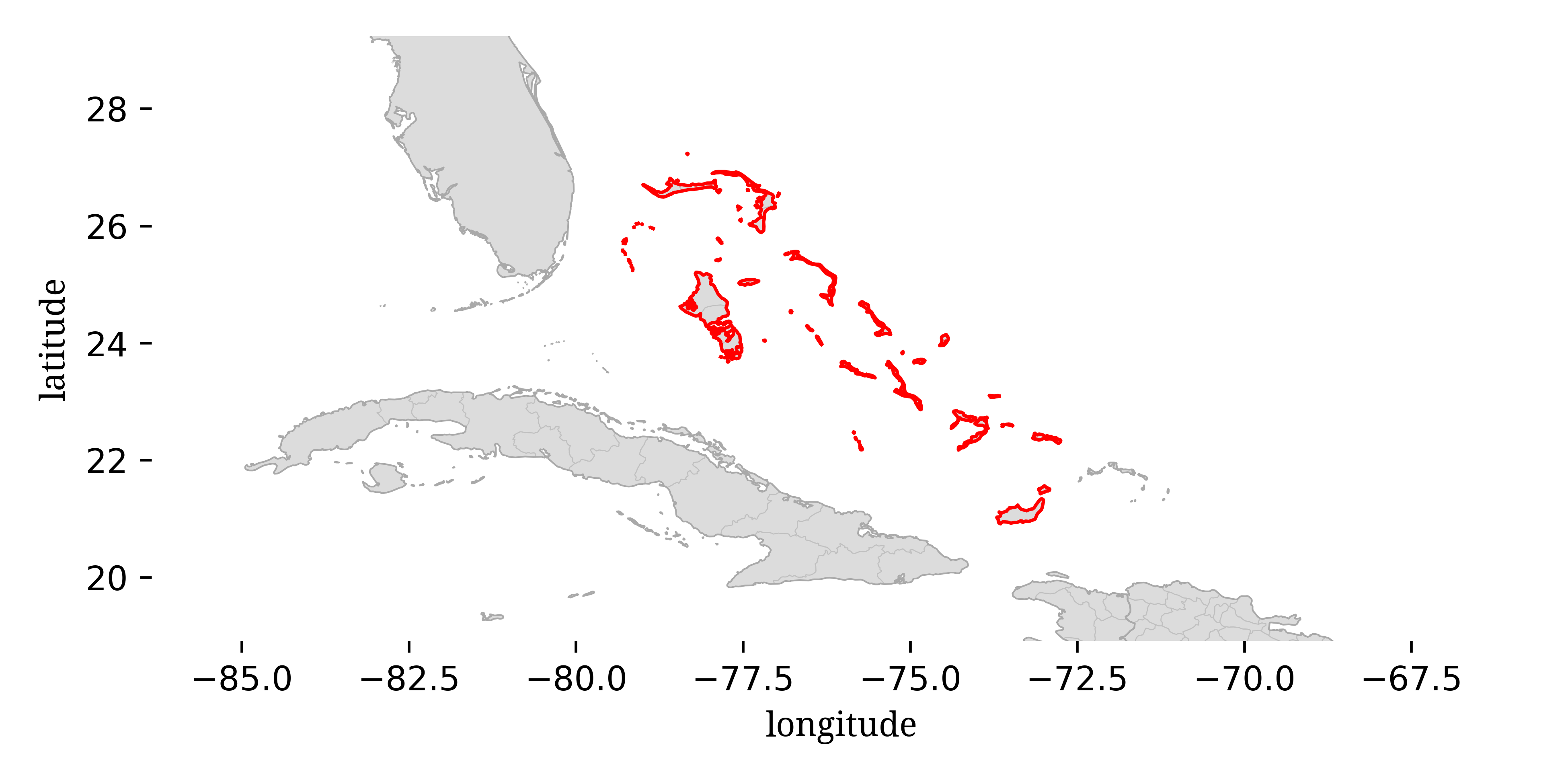
This guide is designed for identification “in the field” where you might be looking at live crabs by eye or through binoculars or from photographs. I will generally try to avoid characters that will require you to physically catch the crab, although I may mention a few for secondary verification. It does not include the more strict taxonomist-style characters that may only be visible under a microscope or via dissection. It is also assumed that the individuals are living, as death (and even capture) can cause dramatic color change.

This is a guide to the fiddler crabs of the Bahamas. Like Florida, the Bahamas represents a transition zone betetween the Atlatnic coast species to the north and the Caribbean species to the south. There are seven species found in the Bahamas:
A number of features can be used to distinguish among these species, but a good place to start is to look at the distance between the base of the eyestalks. Fiddler crabs tend to split into two groups, those with the eyestalks very close together (“narrow front”) and those with the eyestalks separated a bit more (“broad front”). One of these species, Uca major, is a narrow front species, while the others are broad front species.
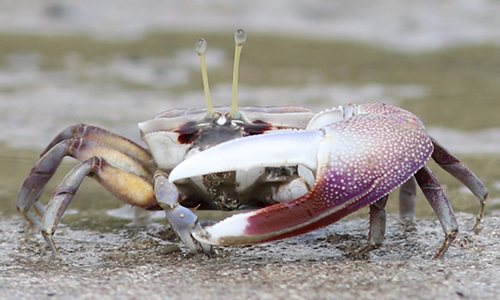

Uca major is readily recognizable in the region as it is both the only narrow front and much larger than other species in the area. Its carapace is generally white or dark brown/red, it has long yellow eyestalks, the upper finger on the claw is white, and the lower finger has a deep wine red patch on it.
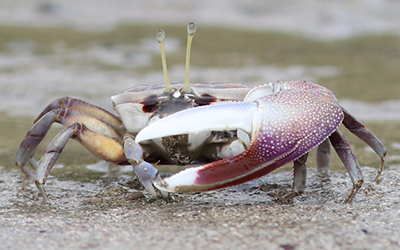

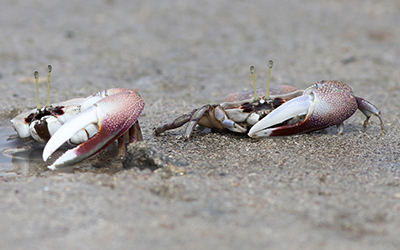
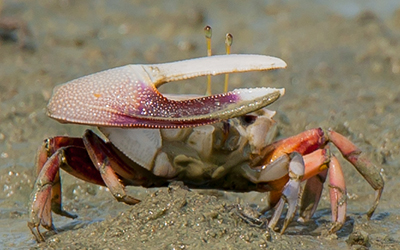
Of the various broad front species, Leptuca thayeri has the narrowest front and has been viewed as borderline narrow front in the past. Its front is clearly broader than that of Uca major (which has a pinched shape), but is notably narrower than that of the other broad front species. In Leptuca thayeri the bit of carapace that comes between the eyestalks has parallel edges, making the extrusion relatively rectangular in shape. In the other broad front species, the edges of the carapace between the eyes slope together, making the extrusion appear more trapezoidal.

Leptuca thayeri tends to be relatively solid colored (both carapace and legs), either a dull brown or dark red. The large claw also tends to be almost entirely a solid color, usually dull orange or fading to a salmon pink, with the tips of the claw sometimes a paler white.
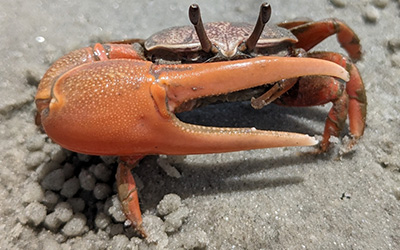
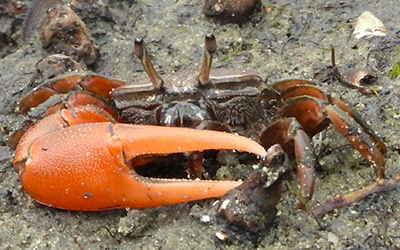
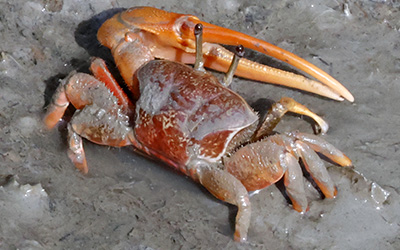
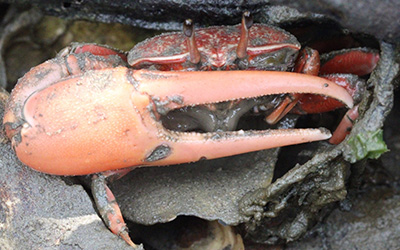
The final charactersistic to help distinguish Leptuca thayeri are some subtle differences in the shape of the large claw. Larger male Leptuca thayeri have fingers on the large claw that are relatively longer, compared to the size of the “hand”, than most of the other local species. In addition, in all of the other three species, the lower finger of the large claw (the pollex) is generally fairly straight, with a bit of upward curvature toward the end. In many male Leptuca thayeri (although not all), this finger will curve back downward toward the end. The extra-long fingers with the downward curve is quite distinct once you learn to recognize it, although smaller male Leptuca thayeri may not show this feature. Compare the shape of the lower finger of the large claw in the photos below to those of the other species (as well as the other Leptuca thayeri above).
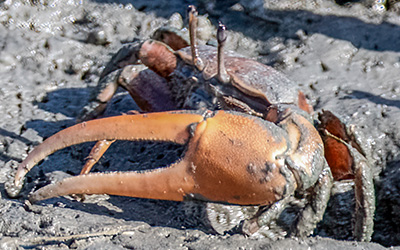
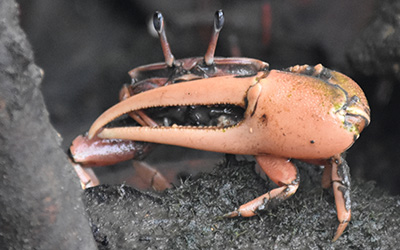
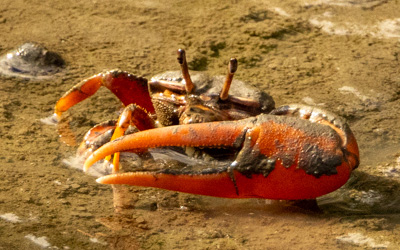
Leptuca leptodactyla prefers sandier beaches and is generally distinguishable by color and the particularly long, thin fingers on its large claw. It has a carapace that ranges from dark gray to almost pure white, occasionally somewhat yellow. The limbs and claw are generally a mix of yellow and white.


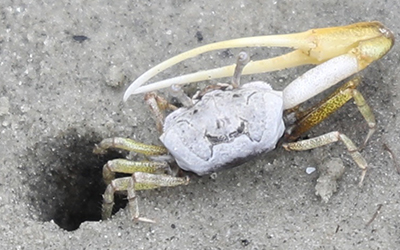
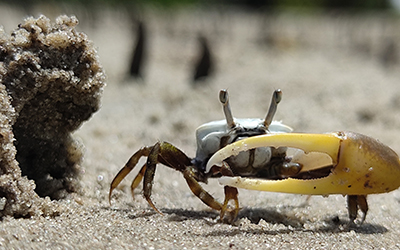
It will sometimes build structures next to its burrows (see fourth photo above), much like its Pacific coast relatives.
Leptuca speciosa is the most similar species in the Bahamas to Leptuca leptodactyla, but with a claw with relatively shorter and thicker fingers (not particularly short or thick, just more so than the extreme that is found in Leptuca leptodactyla). It sits somewhat between the extreme delicateness of the claw of Leptuca leptodactyla and the slightly heavier looking claws of Minuca rapax and Minuca burgersi.
Leptuca speciosa tends to have a predominantly white, very smooth looking claw. In some cases the claw is entirely gleaming white. The body and limbs range a creamy pale yellow to medium green.
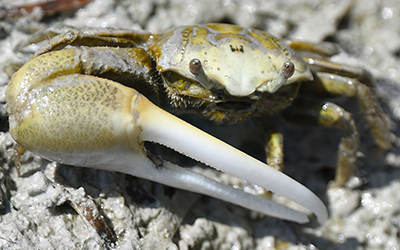
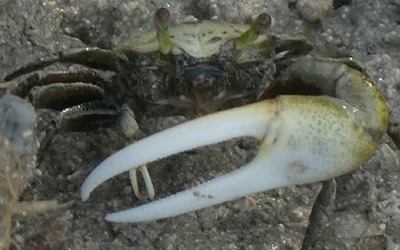
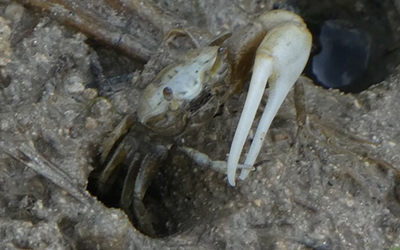
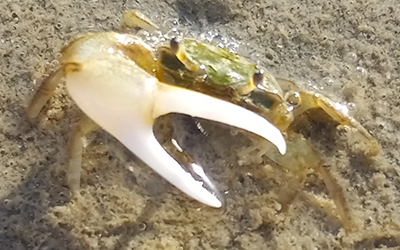
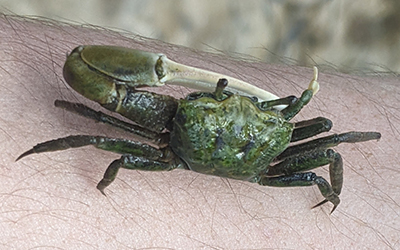

A subtlety of carapace shape can help identify this species as well. Compared to some other species, the sides of the carapace coming back from the front corners tend to be appear particularly straight and squared off, before sharply converging.
Leptuca pugilator is generally found on ocean or near-ocean shorelines up and down the coast, particularly in sandier areas. It is a highly variable colored species, with a carapace (that is the “shell” covering its back) that can range from appearing almost a solid, very dark blue to almost pure white. More often than not it will be in between these extremes, often with a blotchy/marbled appearance. In some individuals, the outer edges of the carapace may be red or orange.
The key indicator, however, is that there is almost always a patch of purple coloration in the center of the upper half of the carapace (it may be missing in individuals that are extremely white). This patch tends to be shaped roughly like a V with the bottom of the letter pointing between the eyes, although the shape of the patch is less important than any evidence of purple. You can see it in every single one of the following photos, even in the ones that appear mostly blue, if you look carefully. This purple coloration is a key indicator; if it is present, then it is this species. A few of the other species can have purple speckling on the front of the carapace, in particulary Minuca rapax, but that speckling appears quite different than the patch of purple usually found in Leptuca pugilator.
The following photos were chosen to demonstrate the range of variation in carapace colors.
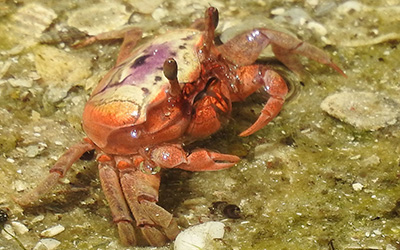
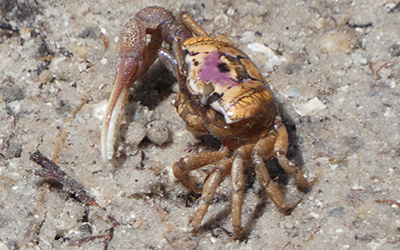
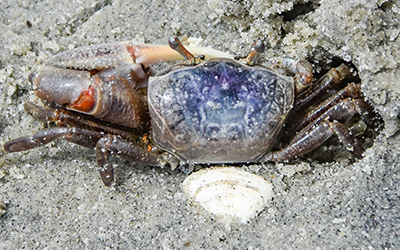
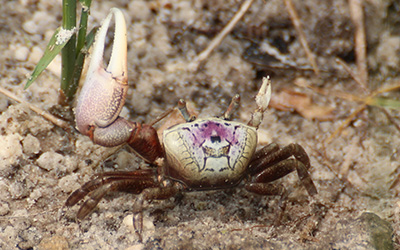
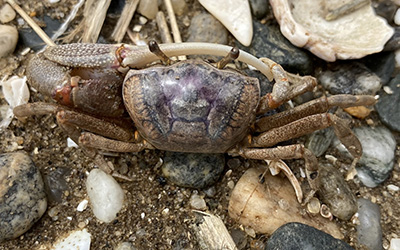

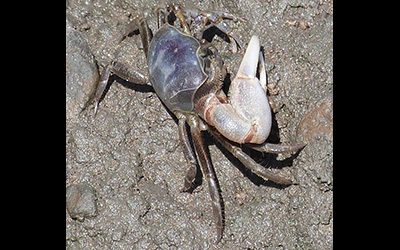
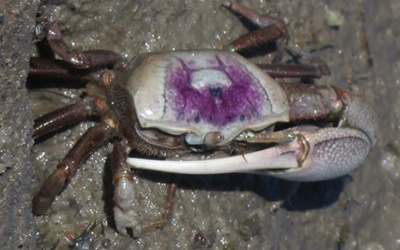
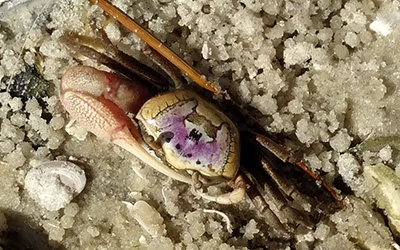
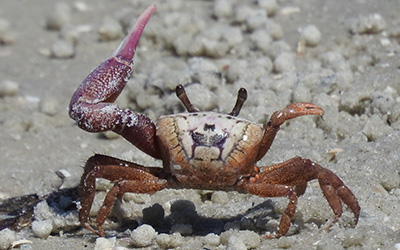


Like the carapace, both the large and small claws of Leptuca pugilator can vary quite a bit in color, from a dark purple/red to mostly white.
Many of the Atlantic Minuca have predominantly two-toned carapaces, tending to have one color (or pattern) over the front half and a different, darker color over the back half. For Minuca burgersi, the front of the carrapace is generally gray, with some purple marbling, with the back half more solid chocolate-brown or purple-brown. The H-shaped depression in the carapace is frequently a purplish red-brown. The large claw is generally a medium orange with paler fingers.

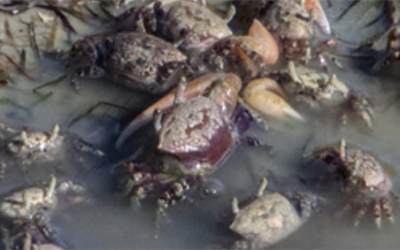
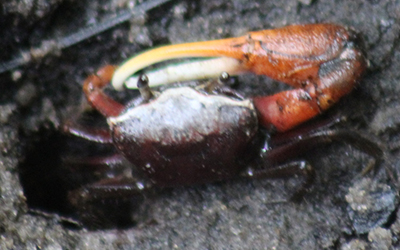
Minuca rapax appears to be one of the most common, and most variable, of the western Atlantic species. It is quite similar to Minuca burgersi, although trends toward more grays and less purple/reds. One of the challenges with a site like iNaturalist is that Minuca rapax seems to be the default "suggested species" for a large part of the western Atlantic, so a lot of the photographs identified as this species are likely other similar species from the same genus, which makes identifying the actual degree and range of color variation in this species difficult.
The two-toned coloration of the carapace of Minuca rapax appears to primarily be a lighter gray in the front half and a darker gray in the back half, but there may be quite a bit more variation beyond this. The claw is generally a medium to pale yellow-orange, with the lower finger trending toward white. There is frequently some purple speckling at the front of the carapace behind the eyes. It is less usual for the H-shaped depresion to be distinctly colored.
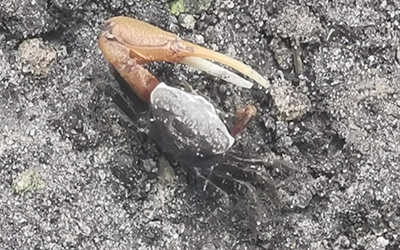
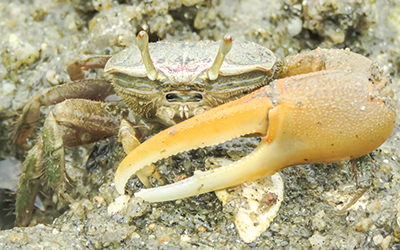
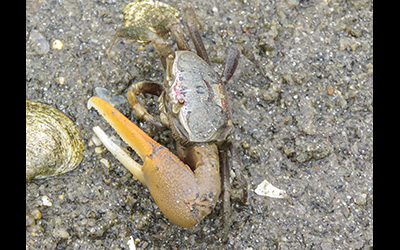
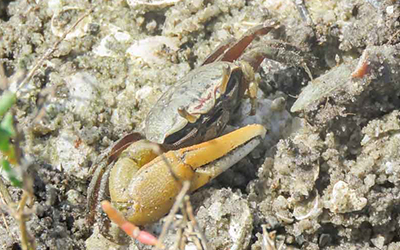
One subtle difference between Minuca rapax and Minuca burgersi is the breadth of the front. While Minuca generally have the broadest fronts of any fiddler crabs, within the genus the species split into roughly two groups, those whose front is less than ⅓ of the width of the total carapace and those whose front is ⅓ or more of the width of the total carapace. Of these two species, Minuca rapax has the narrower front and Minuca burgersi the wider front. Front width can be difficult to estimate with any accuracy (particularly in the field), as it is formally measured as the distance between the margins of the eyebrows, but there are individuals where the front is particularly broader or narrower. An additional complication is that within a species, the relative width of the front increases as crabs get larger (smaller individuals have relatively narrower fronts than larger individuals). Despite all of this, it is still a character that may sometimes be useful in distinguishing these two species.